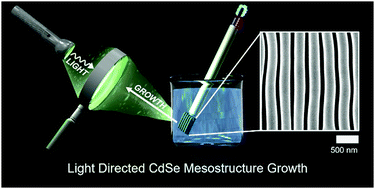Optically tunable mesoscale CdSe morphologies via inorganic phototropic growth†
Abstract
Inorganic phototropic growth using only spatially conformal illumination generated Se–Cd films that exhibited precise light-defined mesoscale morphologies including highly ordered, anisotropic, and periodic ridge and trench nanotextures over entire macroscopic substrates. Growth was accomplished via a light-induced electrochemical method using an optically and chemically isotropic solution, an unpatterned substrate, and unstructured, incoherent, low-intensity illumination in the absence of chemical directing agents or physical templates and masks. The morphologies were defined by the illumination inputs: the nanotexture long axes aligned parallel to the optical E-field vector, and the feature sizes and periods scaled with the wavelength. Optically based modeling of the growth closely reproduced the experimental results, confirming the film morphologies were fully determined by the light–matter interactions during growth. Solution processing of the Se–Cd films resulted in stoichiometric, crystalline CdSe films that also exhibited ordered nanotextures, demonstrating that inorganic phototropic growth can effect tunable, template-free generation of ordered CdSe nanostructures over macroscopic length scales.

- This article is part of the themed collection: Journal of Materials Chemistry C HOT Papers


 Please wait while we load your content...
Please wait while we load your content...
